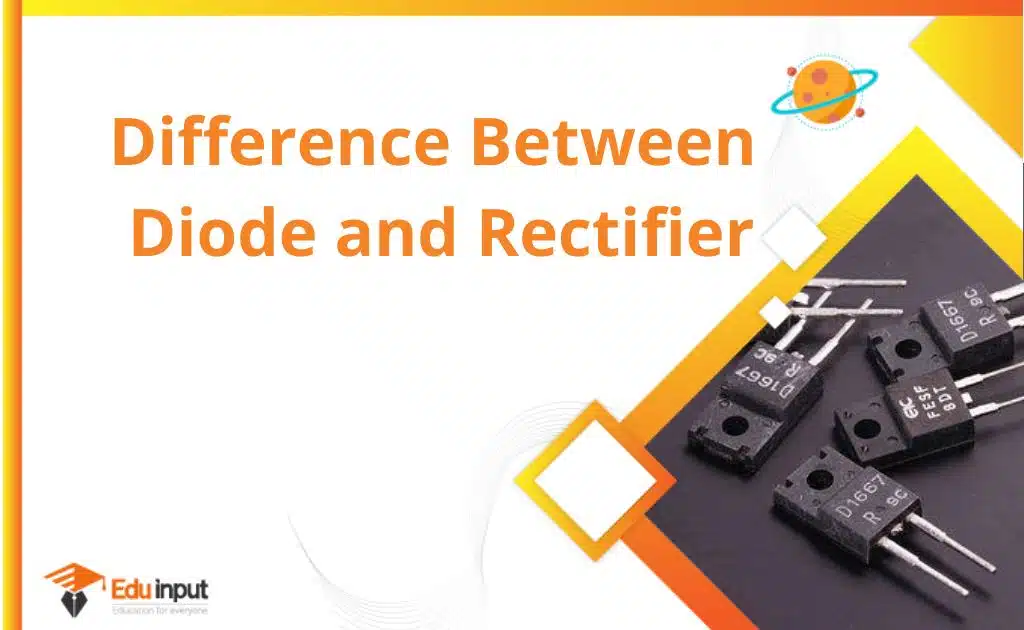Difference between Zener Breakdown And Avalanche Breakdown
The major difference between Zener breakdown and avalanche breakdown lies in the way they occur. Zener breakdown happens as a result of a strong electric field, while avalanche breakdown takes place due to the impact of free electrons with atoms.
It’s possible for both of these breakdowns to happen at the same time. Let us discuss the main difference between zener breakdown and avalanche breakdown.

What is Zener Breakdown?
The Zener breakdown in a p-n junction zener diode occurs when a high reverse voltage is applied across the junction and a heavy current flow in a circuit. The Zener voltage is the value at which this breakdown occurs.
This type of breakdown is temporary and the p-n junction returns to its original state once the reverse voltage is removed. Zener breakdown occurs in heavily doped p-n junction diodes with a thin depletion region.
What is Avalanche breakdown?
Avalanche breakdown is a type of breakdown in a p-n junction diode where the applied reverse voltage causes an increase in the velocity of charge carriers. These charge carriers collide with semiconductor atoms and create a large number of electron-hole pairs.
This leads to an avalanche of free-charge carriers and a high reverse current, which permanently damages the p-n junction. The voltage at which this occurs is called the avalanche breakdown voltage.
Difference between Zener breakdown and Avalanche Breakdown
Zener and avalanche breakdowns are two phenomena in PN junction diodes caused by reverse voltage or high electric field. Zener breakdown occurs at the lower reverse voltage and results in a constant reverse voltage across the diode.
Avalanche breakdown occurs at the higher reverse voltage and results in varying voltage. Both have specific characteristics and applications. Key Differences between Zener breakdown and Avalanche Breakdown are listed below:
Definition
The Zener breakdown in a p-n junction diode occurs due to the tunneling effect or field ionization, while the avalanche breakdown occurs due to impact ionization and an increase in the number of free electrons flowing in the reverse direction.
Breakdown voltage
The Zener voltage, denoted by VZ, is the reverse voltage at which the Zener breakdown occurs. It is typically in the range of 5 to 8 volts. On the other hand, the avalanche breakdown voltage is the reverse voltage at which the avalanche breakdown takes place and is usually greater than 8 volts, which is higher than the Zener voltage.
Depletion region
The Zener breakdown occurs in p-n junction diodes with a thin depletion region, while the avalanche breakdown occurs in diodes with a thick depletion region.
Destruction of junction
The PN junction of the diode does not destroy in zener breakdown while in avalanche breakdown the PN junction of the diode is permanently destroyed.
Electric field
In avalanches breakdown, the electric field is weaker than zener breakdown across the PN junction. The electric field across the PN junction is very strong in zener breakdown.
Doping level
The phenomenon of zener breakdown takes place in PN junction diodes that are heavily doped. But in case of avalanche breakdown, a diode having any level of doping can be used.
Reverse Voltage
Avalanche breakdown occurs at a high reverse voltage or more than zener voltage. But zener voltage occurs at low reverse voltage as compared to avalanche breakdown.
Ionization
Ionization is different in zener and avalanche breakdown. In zener breakdown, the electric field ionizes the PN junction while in avalanche breakdown ionization is due to collision between atoms and free electrons.
Temperature’s Influence on Breakdown Voltage
The chances of zener breakdown increase when temperature decreased. But the avalanche breakdown increase when there is an increase in temperature. So avalanche breakdown has direct relation with temperature and zener breakdown has an inverse relation with temperature.
Voltage Shift after Breakdown
The reverse voltage across the PN junction diode becomes constant once zener breakdown occurs. In case of avalanche breakdown voltage across the PN junction may vary after the breakdown.
Temperature coefficient of voltage
The temperature coefficient of zener breakdown is negative as it has an inverse relationship with temperature. Avalanche breakdown has a direct relation with temperature so its temperature coefficient of voltage is positive.
Effect on PN junction
The PN junction regains its original state after the zener breakdown. But in an avalanche breakdown, it is permanently destroyed and never regains its original state.

Related FAQs
Why do Zener breakdown and avalanche breakdown increase with temperature?
In avalanche breakdown, electrons knock other electrons into the conduction band creating electron-hole pairs. Due to an increase in temperature, vibrations of atoms increase and thus reduce the mean free path for electrons. Hence an increase in temperature increases the breakdown voltage.
Which breakdown occurs first Zener or Avalanche?
Zener breakdown occurs in the zener diode. A Zener Diode experiences avalanche breakdown when the reverse voltage (Vz) is greater than 8 volts due to the separation of electrons and holes.
Can we use a diode after the avalanche breakdown?
No, a diode that has undergone avalanche breakdown cannot be used again. The PN junction of the diode is permanently destroyed during avalanche breakdown and cannot be regained its original state.
What happens to the current after Zener’s breakdown?
After Zener breakdown in a p-n junction diode, the reverse voltage across the diode becomes constant and the current flowing through the diode increases significantly. This is because the PN junction acts as a low resistance path for the flow of current. This allows for the regulation of voltage in the circuit.







Leave a Reply